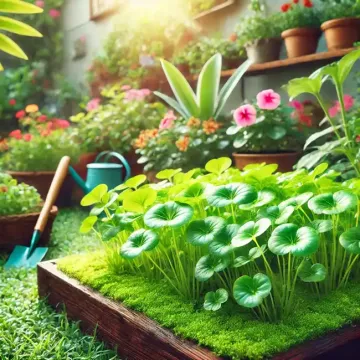Watercress (Nasturtium offcinale) is a highly nutritious leafy green that has been enjoyed for centuries. Known for its peppery flavor and rich vitamin content, it is a versatile addition to salads, sandwiches, soups, and more. Watercress is a semi-aquatic plant that thrives in cool, freshwater environments, making it an exciting and rewarding plant to grow at home. With the right conditions, you can cultivate this nutrient powerhouse in your own garden, even if you don’t have a natural water source.
History of Watercress Watercress has a long history dating back to ancient civilizations. It was highly regarded by the Greeks and Romans, who believed it had medicinal properties, particularly for digestive health. The Victorians popularized watercress sandwiches as a staple of British tea culture. Today, it remains a symbol of healthy eating and has even been classified as a superfood due to its high levels of vitamins A, C, and K, as well as calcium and iron.
Health Benefits Watercress is often hailed as one of the most nutrient-dense vegetables. It is packed with antioxidants that help combat oxidative stress and inflammation in the body. The vitamins and minerals found in watercress contribute to bone health, immune function, and skin health. Additionally, watercress contains glucosinolates, which have been studied for their potential cancer-preventative properties. Including watercress in your diet regularly can promote overall health and well-being.
Growing Watercress: Ideal Conditions
- Water: As a semi-aquatic plant, watercress thrives in wet conditions. It naturally grows in slow-moving streams and freshwater sources, so maintaining consistent moisture is key to successful growth. If you don’t have access to a stream, consider growing watercress in containers, using shallow trays, or planting it in a water garden. Regular watering is essential to keep the soil consistently moist.
- Light: Watercress prefers partial shade to full sun. While it can tolerate some direct sunlight, too much heat can cause the plant to bolt, reducing its flavor. In warmer climates, providing shade during the hottest part of the day is beneficial.
- Soil: The ideal soil for watercress is rich, loamy, and slightly acidic (pH 6.5-7.5). A well-drained yet consistently moist environment is essential. If you’re growing watercress in soil, ensure good drainage to prevent waterlogging while keeping the soil damp.
- Temperature: Watercress thrives in cooler temperatures, ideally between 50-60°F (10-15°C). It grows best in spring and fall, avoiding the heat of summer. In hot climates, watercress may be grown as a cool-season crop, or shaded areas can extend its growing season.
Planting Watercress Watercress can be started from seeds or cuttings. If you choose seeds, start them indoors about four to six weeks before the last frost. Sow seeds in shallow trays with a rich, loamy growing medium and keep the soil consistently moist. Once seedlings are a few inches tall, they can be transplanted outdoors.
If you’re planting watercress in containers, choose a container with drainage holes and keep it in a saucer filled with water to mimic the plant's natural wet environment. For water gardens, place the watercress near the edge of a pond or in a container submerged in water.
Care and Maintenance Watercress is relatively low-maintenance as long as it gets enough water. Regular harvesting encourages new growth and helps prevent the plant from flowering too early. Pinch off the tips of the plant to encourage bushier growth and to keep it from becoming leggy.
Watch for pests like aphids and caterpillars, which can be managed with natural insecticides or by introducing beneficial insects like ladybugs. In terms of diseases, watercress can be prone to fungal issues in overly damp conditions without proper airflow, so ensure the plants aren’t overcrowded.
Harvesting Watercress Watercress is ready to harvest when it reaches about 4-6 inches in height. You can start harvesting the outer leaves once the plant has established itself. Use scissors or garden shears to snip off leaves and stems, leaving the central part of the plant intact to encourage regrowth. Watercress grows quickly, so regular harvesting will keep the plant producing fresh leaves.
The flavor of watercress is best when harvested young and tender. Older leaves can become tough and overly spicy.
Culinary Uses Watercress is a versatile green that can be used fresh in salads, sandwiches, and garnishes. It also works well in soups, especially when lightly cooked to preserve its peppery flavor. Blending watercress into smoothies or pesto is another way to enjoy its health benefits. Because of its strong taste, it pairs well with mild and creamy ingredients, such as cheese and avocado.
Growing watercress in your home garden can be a fulfilling experience, providing a continual supply of nutritious greens. While it may require a little extra care in maintaining the right moisture level, the rewards of harvesting your own fresh watercress are well worth the effort. Whether you’re looking to enhance your diet or add a new dynamic to your garden, watercress offers both flavor and nutrition that can elevate your meals.

